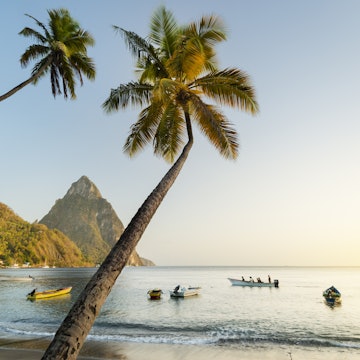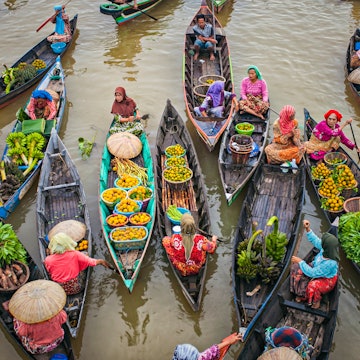

P’chum Ben (Festival of the Dead) in Phnom Penh. Wirestock Creators/Shutterstock
Nick Ray is the author of the Phnom Penh and Siem Reap chapters of Lonely Planet's Cambodia guidebook, which was published in September 2025.
Some Cambodians wryly observe that Cambodia has three seasons: hot, hotter and hottest. But in reality, there are distinct dry and wet seasons that define the harvest cycle and dramatically alter the character of the landscape in this fascinating Southeast Asian nation.
The dry season runs from November to May, and the comparatively cooler months of November to February are the most popular time to visit Cambodia due to the milder temperatures. The countryside appears somewhat parched from February to May, when daytime temperatures can soar above 40°C (104°F).
The wet season usually runs from June to October, coinciding with the southwest monsoon, but it's not necessarily a bad time to travel to Cambodia. It usually only rains heavily once a day toward sunset, the countryside is a blaze of green, and many hotels and resorts offer substantial discounts.
Here's a guide to the best times to visit Cambodia.

Siem Reap weather overview
Dry season: November to April, with temperatures from 21–32°C (70–90°F)
Wet season: May to October, with temperatures around 30°C (86°F)
Highest rainfall: September
When is the best time to travel in Cambodia?
During the high season (November to March), the weather in Cambodia is not unlike a Mediterranean summer. Temperatures occasionally drop below 20°C (68°F), forcing Cambodians to scramble for their coats and woolens. This makes exploring much more pleasant, but it's also the most crowded time at the temples of Angkor. Lots of accommodations are fully booked well in advance, particularly over the Christmas and New Year's period and during Chaul Chnam Chen (Chinese New Year), which follows the lunar calendar, falling in January or February.

When is the best time to visit Angkor Wat?
It is possible to visit Angkor Wat at any time of year, but the peak season is from November to February, when the weather is dry and cooler, although it’s still hot. In December, international athletes arrive for the Angkor Wat International Half Marathon. This half-marathon has been a fixture on the sporting calendar for two decades. In May or June, Visakha Puja (Buddha Day) sees processions of monks carrying candles through Angkor Wat at night. The festival falls on the eighth day of the fourth moon (in May or June).
When is the best time for families to visit Cambodia?
Despite being in the middle of Cambodia's wet season, July and August don’t get that much rain; however, there's enough water to swell Tonlé Sap Lake. This is an ideal time for families living in Europe and North America to visit Cambodia, thanks to the long school holidays and discounted prices at hotels and resorts. Far fewer tourists are exploring Angkor during this green season, when the moats are full of water and many of the temples are coated in moss and lichen. The main drawback of shoulder season travel is that it can rain quite heavily on the coast, meaning Ko Rong and other idyllic islands near Sihanoukville can be quite wet and windy.

When's the best time to visit Cambodia's islands and beaches?
November to March is high season on Cambodia's islands and beaches, with the peak period in December and January, when places fill up fast and prices are at their highest. Some argue that April through May is the best time to visit for hot weather without the crowds. From June, the rains descend, but if you don’t mind contemplating storm clouds brewing on the horizon from your porch, you get the bonus of snagging a bungalow bargain.
When is the best time for budget travel in Cambodia?
When it comes to weather, the months of April to June and September and October are definitely not the best. Temperatures in April and May can reach scorching levels, and September and October are wet, wet, wet. However, accommodations release their best special offers. You can save a huge amount of money if you plan on staying at five-star hotels and luxury resorts. September and October are the height of the rainy season, but this also brings emerald landscapes and epic cloud formations.

A guide to festivals and events in Cambodia
Many of Cambodia's big festivals follow the lunar calendar and spill across more than one month on the Gregorian calendar. Here's a guide to what is happening throughout the year.
Chaul Chnam Chen (Chinese New Year) and Tet (Vietnamese Lunar New Year): Both fall in either January or February, depending on the year.
Chaul Chnam Khmer (Khmer New Year): During the three-day celebration of Chaul Chnam Khmer in mid-April, Cambodians make offerings at wats, clean out their homes and exchange gifts. Good-natured water fights spill across the country (throwing talcum powder is also popular).
Chat Preah Nengkal (Royal Ploughing Ceremony): Presided over by the royal family, Chat Preah Nengkal is an ancient agricultural festival held to mark the traditional beginning of the rice-growing season in early May. After a procession, select oxen are led to trays containing sesame seeds, corn, beans, rice and grass, where they're believed to predict the crop that will perform well that year.
Visakha Puja (Buddha Day): A celebration of Buddha’s birth, enlightenment and parinibbana (passing), Visakha Puja in May sees locals flock to wats to pay their respects.
P’chum Ben (Festival of the Dead): This September festival resembles the Christian celebration of All Souls’ Day, when respects are paid to the dead through offerings made at wats. Local temples are ablaze in color, ceremonies and chanting.
Bon Om Tuk (Water and Moon Festival): Celebrating the victory of Jayavarman VII over the Chams, this important festival in October or November also marks the extraordinary natural phenomenon of the reversal of the flow of the Tonlé Sap River. It’s a wonderful, chaotic time to be in Cambodia, with boat races at Sisowath Quay in Phnom Penh and riverside parties in Siem Reap.
Angkor Photo Festival: In Siem Reap, resident and regional photographers descend on the temples and team up with local youths to teach them the tricks of the trade at this civic-minded festival in November or December. Photography exhibitions are staged all over town.














